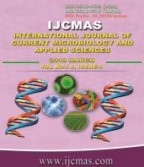


 National Academy of Agricultural Sciences (NAAS)
National Academy of Agricultural Sciences (NAAS)

|
PRINT ISSN : 2319-7692
Online ISSN : 2319-7706 Issues : 12 per year Publisher : Excellent Publishers Email : editorijcmas@gmail.com / submit@ijcmas.com Editor-in-chief: Dr.M.Prakash Index Copernicus ICV 2018: 95.39 NAAS RATING 2020: 5.38 |
Diabetes mellitus is a metabolic disorder characterised by chronic glycemia1Twenty five percent diabetic patients have a risk of developing foot ulcer and limp amputation was 15-45%higher than non diabetic ulcer2.Aims: To determine the antibiotic resistance pattern of diabetic foot isolates. A total of 75 specimens (pus, swab, aspirated pus, debridement tissue) were collected from diabetic ulcer patients and the specimens processed by manually. Majority of patients (80%) were in the age group of 51to70 years. The aerobic pathogens isolated were predominantely gram negative (79) and gram positive (28) bacteria. Of these 107,70 gram negative bacilli and 20 gram positive cocci were isolated in the age group between 51 to 70 years. Of 70 gram negative bacilli Pseudomonas species was the predominant, among the gram positive cocci Staphylococcus aureus was predominant. In most of the infections in the age group between 51 to 70 years, it was polymicrobial. The antibiogram of the isolates showed that most of the Pseudomonas species was resistant to 3rd generation cephalosporins (74%), quinolones (76.9%).Klebsiella species 100% resistant to amoxicillin and majority of them also resistant to 3rd generation cephalosporins, E. coli showed high amount of resistance to amoxicillin, cefotoxime, piperacillin. Citrobacter species showed 100% resistant to amoxicillin, cefuroxime, cephalexin. Acinetobacter species showed 100% resistant to amoxicillin, 3rd generation cephalosporins, meropenem, ciprofloxacin, gentamicin. Staphlococcus aureus 100% sensitivity to vancomycin, chloramphenicol, novobiocin.
 |
 |
 |
 |
 |